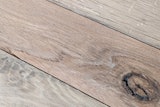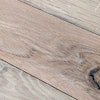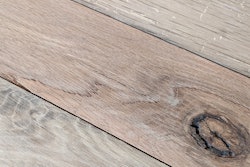The Problem
A few months ago, a homeowner called to complain about getting slivers from the recently installed wood flooring in his new home. The owner claimed the wood flooring was not installed at the time of inspection with the builder. The builder gave our name as the supplier of the prefinished wood flooring, so I was called to do an inspection.
The Procedure
From the moment the door was opened, I was bombarded with a range of temperament. The homeowner was expressing a great deal of frustration and anger. I have found in my years of experience that it is good practice to allow homeowners the opportunity to vent all their frustrations. This gives them a chance to express their concerns and it often gives me insight into the reasons the problem has occurred. In this case it really didn't matter what was said, because the problem stood out right out before my eyes.
The floor was dark brown, 2 1/4-inch prefinished strip with cracks down the sides of several boards. Since the homeowner was still talking and upset, I asked him to open the drapes so I could have a better look at the floor.
When the drapes opened and the natural light shone across the floor, I could see that the entire floor was completely split and damaged. It was no wonder the homeowner was disappointed in what he perceived to be the quality of the wood flooring.
Without removing pieces of wood from the floor, the first thing I did was check the nailing pattern. This can easily be done using a metal detecting stud finder. In this case, the nailing pattern was 6 to 7 inches on center, and it was much tighter than normal.
The floor heating register was pulled out to determine the thickness of the subfloor. There was no problem with the subfloor, since it was 3/4inch thick. But guess what—the floor was 1/2 inch thick, not the expected 3/4-inch-thick floor you would normally find with a 2 1/4-inch face.
Further inspection led me to the basement, where every row of cleats could be seen substantially protruding through the subfloor and the ceiling.
The Cause
Figuring out the cause can be like detective work, and the only way to determine it is to review the facts:
1. The floor was consistently split along the edge of the wood flooring on the tongue side.
2. The floor was 1/2 inch thick.
3. The cleats are 2-inch and nailed at 6 to 7 inches on center.
What do these clues say to you?
I told the homeowner about the cause of his problems and informed him that the next course of action was to discuss the situation with the builder and the installer.
I discovered that the installer had experience with 3/4-inch flooring only; he had never worked with 1/2-inch product. On this project, he therefore used a manual nailer designed for 2-inch cleats. This equipment has too much power and caused the flooring to split, virtually blowing out the tongue side of the boards along the edges.
When installing 1/2-inch flooring, the smaller, lightweight nailer and mallet with a 1/2-inch adapter plate should be used with 1 1/4-inch cleats. The spacing should be approximately 8 to 9 inches on center. This nailer is lightweight and does not require as much force or pounding to set the flooring.
How to Fix the Floor
Unfortunately, using the wrong nailer resulted ina seriously damaged floor—one that could not be repaired and thereby required complete removal. Because the installer had no previous experience installing 1/2-inch flooring and ultimately caused the damage, he was responsible for all costs to replace the wood flooring.
In the Future
Always read the manufacturer's recommended procedures, especially when working with a new or different product. On this job, when the new wood flooring was being installed, I explained the correct installation procedures and assisted with on-site directions. The correct equipment and cleats were used, the correct nailing schedule was followed, and the floor looked fantastic. The homeowner was very pleased with the end result. To this date, the wood flooring installer continues to use 1/2-inch flooring because of its ease of installation and adaptability when it comes to new construction.
I believe that there is no such thing as a stupid question if you don't know the answer. So ask the question!

































